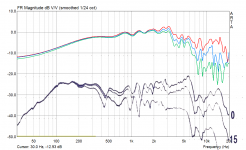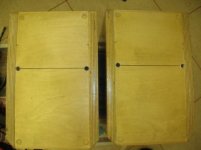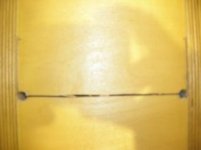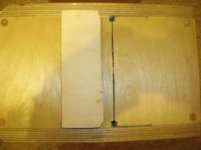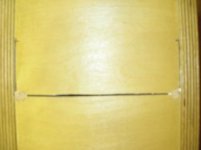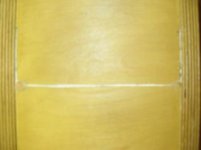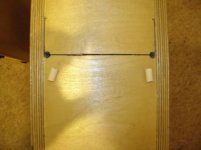So that was quick - keep us posted
I have a quick question the Paper Alpairs come with a gasket
(the metal Alpair gasket was different) I think it was a sort of foam.
Which side of the gasket goes against the driver?
I assume its the sticky side..remove the paper and stick the gasket to the back of the Alpair?
Regards
M. Gregg
Last edited:
I have a quick question the Paper Alpairs come with a gasket
(the metal Alpair gasket was different) I think it was a sort of foam.
Which side of the gasket goes against the driver?
I assume its the sticky side..remove the paper and stick the gasket to the back of the Alpair?
Regards
M. Gregg
Yes
Hello
i am sorry for the broken driver.
Now what to get as a replacement?
Imho a great example of a typical problem of Marksudio drivers: not possible to buy replacements after a short period of time....
So as a replacement you can buy two new MA drivers (when only one is broken afaiu) and the old cabinet is not ideal for the new MA driver. So why buy Ma drivrrs again? The next time a drivers gets damaged you have to hunt for another pair and have to put them in a not ideal cabinet again.
Dosen't make sense imo.
There are many different alternatives on the full range market (Tang Band, Visaton, Wavecor, Monacor and Vifa/Peerless to name a few) which have drivers available for many years
Regards
Hi Sayrum,
You forget that the development of Markaudio drivers is at the request and feedback from members of Diyaudio.
None of the other drivers makers you mention listen to you. They don't consult Diyaudio members on their driver design and development. They don't pay a cent towards Diyaudio to help keep this site and its forums operational.
Since my cancer diagnosis in January 2013, I've done my best to keep going, due mostly to the large support I received from members at the time. Many members encouraged me to carry on with the development of Markaudio drivers. Do a search on Diyaudio to confirm these many requests.
Naturally, you're welcome to your opinion, but it a shame that what you say is "mad" is too dismissive, lacks respect for the efforts made over the years of Diyers input to Markaudio driver development.
Maintaining my functional health remains a challenge. My ability and energy levels remain variable, medical treatment continues. However, I'll still do what I can to support driver development. Granted this doesn't suit you personally and won't suit all; But I don't have the resources to please every Diyer all the time. I try my best to make useful drivers for as many as I can.
Mark.
Last edited:
+1And we thank you.
Plus who in this forum doesn't like getting new drivers and building new cabinets!
and a BIG thank you to Mark.... certainly a unique manufacturer/designer!
Hello Marc
Thank you for responding personaly to my post.
Listening to requests of your buyers is aplodable and also sets you apart from many other manufactures.
Never the less the problem imho still stands: by rapidly changing the drivers and discontinuing the old models all speaker / cabinet development (designing) is for the bin...
As mentioned by someone before other companies like TB also change drivers (develop new ones) BUT the old models are still available for many years (at least here in europe).
Wish you strength and perseverance!
That i do not understand!
I see no lack of respect by mentioning a development and imho preety unique characteristic of MA drivers. Like is said before IMHO the constant changing of driver characteristics and discontinuation of models after only a year or so on the market is hindering for many diyfers. I am mad about that because that unique characteristic is one of the reasons here in Germany many developers and diyfers have stopped using MA drivers. I feel that is a loss since i liked to build with your full rangers and was always happy to copy from an existing build with bsc + filters.
Best of luck to you with your recovery!
Regards
Thank you for responding personaly to my post.
I feel it is great to keep on improving + pushing the boundries!Hi Sayrum,
You forget that the development of Markaudio drivers is at the request and feedback from members of Diyaudio.
None of the other drivers makers you mention listen to you. They don't consult Diyaudio members on their driver design and development. They don't pay a cent towards Diyaudio to help keep this site and its forums operational.
Listening to requests of your buyers is aplodable and also sets you apart from many other manufactures.
Never the less the problem imho still stands: by rapidly changing the drivers and discontinuing the old models all speaker / cabinet development (designing) is for the bin...
As mentioned by someone before other companies like TB also change drivers (develop new ones) BUT the old models are still available for many years (at least here in europe).
I am sorry to hear that!Since my cancer diagnosis in January 2013, I've done my best to keep going, due mostly to the large support I received from members at the time. Many members encouraged me to carry on with the development of Markaudio drivers. Do a search on Diyaudio to confirm these many requests.
Wish you strength and perseverance!
Naturally, you're welcome to your opinion, but it a shame that what you say is "mad" is too dismissive, lacks respect for the efforts made over the years of Diyers input to Markaudio driver development.
That i do not understand!
I see no lack of respect by mentioning a development and imho preety unique characteristic of MA drivers. Like is said before IMHO the constant changing of driver characteristics and discontinuation of models after only a year or so on the market is hindering for many diyfers. I am mad about that because that unique characteristic is one of the reasons here in Germany many developers and diyfers have stopped using MA drivers. I feel that is a loss since i liked to build with your full rangers and was always happy to copy from an existing build with bsc + filters.
Best of luck to you with your recovery!
Regards
You forget that the development of Markaudio drivers is at the request and feedback from members of Diyaudio.
I'd like to request a 6" to 8" driver with smooth off-axis behavior that can be used as a satellite from about 80Hz for (small) home theater applications.
There seems to be nothing like this 50 years old Lorenz driver available on the market today:
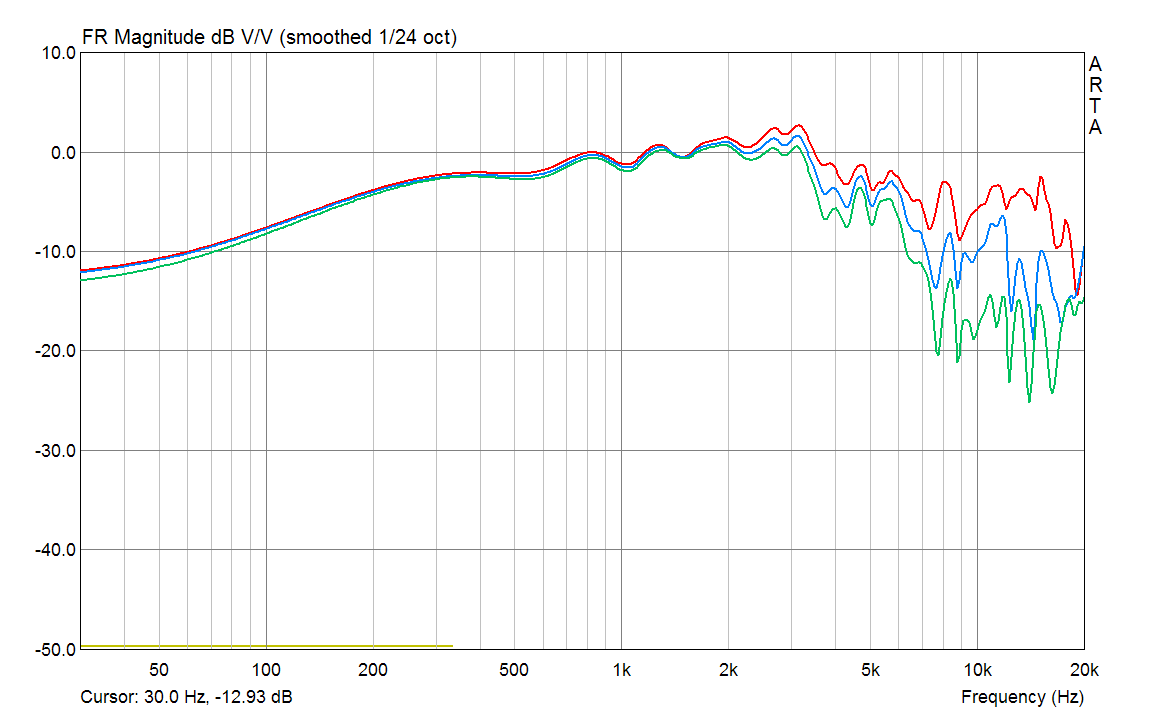
Lorenz S-888 Loudspeaker Measurements and Information
Hello Marc
Thank you for responding personaly to my post.
I feel it is great to keep on improving + pushing the boundries!
Listening to requests of your buyers is aplodable and also sets you apart from many other manufactures. Never the less the problem imho still stands: by rapidly changing the drivers and discontinuing the old models all speaker / cabinet development (designing) is for the bin...
As mentioned by someone before other companies like TB also change drivers (develop new ones) BUT the old models are still available for many years (at least here in europe).
That i do not understand!
I see no lack of respect by mentioning a development and imho preety unique characteristic of MA drivers. Like is said before IMHO the constant changing of driver characteristics and discontinuation of models after only a year or so on the market is hindering for many diyfers. I am mad about that because that unique characteristic is one of the reasons here in Germany many developers and diyfers have stopped using MA drivers. I feel that is a loss since i liked to build with your full rangers and was always happy to copy from an existing build with bsc + filters.
Best of luck to you with your recovery!
Regards
Thanks for your best wishes regarding my health, its is greatly appreciated.
Your exaggerating the situation beyond the real. Markaudio driver service life is long and many 6+ year old projects are still running today. I'm running Gen1 bass Alpair 10 and Gen 1 Alpair 5's as I type. Granted if damage is done to an older generation driver, then the likely need will be to replace with newer units. But I'm not overwhelmed by requests to maintain Gen1, Gen2 and Gen 3 drivers all at the same time. There's no way to remain commercially viable by doing this.
You suggest that driver development should be secondary, rather to maintain existing designs for longer periods. That's not who I am and its not what most Markaudio users want. You've ignored the fundamental "diy" build character of Markaudio.
I'm certain my knowledge and my data for Markaudio EU distribution is far more accurate than the informal comment you mention. Usage of Markaudio drivers in EU remains steady to marginal growth, an excellent result considering the poor economic conditions that the region has suffered for some time. I shipping 300 drivers last week and last August we shipping 3 metric tones of drivers, all the EU!
Naturally, your decision to support other makers is your choice, but I won't be pressured by you to follow their "take what we make" approach.
Thanks
Mark.
Last edited:
I'd like to request a 6" to 8" driver with smooth off-axis behavior that can be used as a satellite from about 80Hz for (small) home theater applications.
There seems to be nothing like this 50 years old Lorenz driver available on the market today:

Lorenz S-888 Loudspeaker Measurements and Information
Hi Pinx, (Guys)
I'd like to expand allot more on your post, but Rutcho (far as I can see) doesn't publish any specific information on his testing environment and testing methodology (anechoic? semi-anachoic? non-anechoic? on-baffle?, if so what sizes are being used? in-closed box? if so what size? etc etc. Also from what I can see, he using sweep test voltages that don't directly relate to the actual REVC on some driver's coils. I'm glad he's doing his work, but he needs to fully disclose his methods and methodology.
A promising example of what's needed in published project and testing comes from Joseph Crowe:
http://www.diyaudio.com/forums/full-range/261366-markaudio-chp-70-project.html
Looking at the Rutcho Lorenz graph (I'm able to comment as this maker is not in production - I hope) its missing data from 2-kHz down, making it difficult to comprehensively comment of this driver's performance spectrum. Its not a driver I'd design and build in a big hurry. Its large drop-off at around 2.5-kHz is right inside the sensitive telephonic band. I'm a bit surprised that such a fundamental has been missed. Its off axis dispersion performance is very restricted so doesn't match up to modern ultra low mass, low profile single cone designs. This Lorenz, according to Rutcho is only rated @ 89dB yet no moving mass (MMS) data is published, somewhat strange situation. A driver of this vintage and size is usually >92dB. Either the R published data is suspect or this is an unusual driver for its time when amp power was limited. Granted its twin-VC design will add mass but this on a 28mm dia. winding body, it shouldn't bring the SPL down quite so low. But I have to stress that I haven't seen any alternative more comprehensive anechoic test data of this driver, so there's no way to verify R's testing in relation to this unit.
In some respects, I'm not surprised that you support this type of limited performance driver. From reading your other posts, you have a disconnection regarding properties of dispersion in relation to range response. Its an increasingly common set of errors being made by newer and/or younger members who've not fully researched the functionality of modern low-mass, wide dispersion, longer throw wide band and full range drivers. I much urge you to do allot more research on these aspects in order to better understand and enjoy full-rangers. Threads on the Markaudio section may help.
Coming back onto topic. It will be interesting to read the outcome from the metal v paper poll. Each material has its strengths and weaknesses. I've commented on these properties on various posts over recent years, a search will reveal more.
Thanks
Mark.
Last edited:
Hi Pinx, (Guys)
I'd like to expand allot more on your post, but Rutcho (far as I can see) doesn't publish any specific information on his testing environment and testing methodology (anechoic? semi-anachoic? non-anechoic? on-baffle?, if so what sizes are being used? in-closed box? if so what size? etc etc. Also from what I can see, he using sweep test voltages that don't directly relate to the actual REVC on some driver's coils. I'm glad he's doing his work, but he needs to fully disclose his methods and methodology.
Please see http://www.diyaudio.com/forums/full...ange-measurements-database-2.html#post4079742 and Loudspeaker Raw Driver Measurements
A promising example of what's needed in published project and testing comes from Joseph Crowe:
http://www.diyaudio.com/forums/full-range/261366-markaudio-chp-70-project.html
I've looked at that thread but I'm not sure what exactly is "promising" about the measurements he shows? Any magnitude response presented on a 100dB scale looks "promising". It would probably be more useful to gate out room reflections and show a 60dB range like everybody else.
Just for comparison here's the Lorenz and your CHP-70 data on the same scale:
By the way, how did you manage the driver to become directional starting at 200Hz?
Looking at the Rutcho Lorenz graph (I'm able to comment as this maker is not in production - I hope) its missing data from 2-kHz down, making it difficult to comprehensively comment of this driver's performance spectrum.
Data is missing? What are you looking for? The graph is obviously made from a gated IR, so it lacks data points at lower frequencies but the goal here is more to show general trends in response and how the driver behaves off-axis. The important part is higher up where most full range drivers have response problems.
Its not a driver I'd design and build in a big hurry. Its large drop-off at around 2.5-kHz is right inside the sensitive telephonic band. I'm a bit surprised that such a fundamental has been missed.
If this can be done better I guess everybody would greatly appreciate it. In the meantime EQ would need to fix this.
Its off axis dispersion performance is very restricted so doesn't match up to modern ultra low mass, low profile single cone designs.
Please define "restricted". The Lorenz seems to fall off rather smooth unlike most other 8" full range drivers. Here's some data: https://mehlau.net/audio/full-range-radiation-patterns/
This Lorenz, according to Rutcho is only rated @ 89dB yet no moving mass (MMS) data is published, somewhat strange situation. A driver of this vintage and size is usually >92dB. Either the R published data is suspect or this is an unusual driver for its time when amp power was limited. Granted its twin-VC design will add mass but this on a 28mm dia. winding body, it shouldn't bring the SPL down quite so low. But I have to stress that I haven't seen any alternative more comprehensive anechoic test data of this driver, so there's no way to verify R's testing in relation to this unit.
If this can be done better I guess everybody would greatly appreciate it.
In some respects, I'm not surprised that you support this type of limited performance driver. From reading your other posts, you have a disconnection regarding properties of dispersion in relation to range response. Its an increasingly common set of errors being made by newer and/or younger members who've not fully researched the functionality of modern low-mass, wide dispersion, longer throw wide band and full range drivers. I much urge you to do allot more research on these aspects in order to better understand and enjoy full-rangers. Threads on the Markaudio section may help.
What would that "disconnection regarding properties of dispersion in relation to range response" be? Did smooth on/off-axis frequency response go out of style without me noticing
Attachments
Last edited:
As mentioned by someone before other companies like TB also change drivers (develop new ones) BUT the old models are still available for many years (at least here in europe).
That propbably has more to do with Europe than with TB. We saw the same thing with Mark Audio drivers (ie CHP70.1 were still available till recently), it was just that not as many made it into Europe.
dave
- Status
- This old topic is closed. If you want to reopen this topic, contact a moderator using the "Report Post" button.
- Home
- Loudspeakers
- Full Range
- Alpair 7
